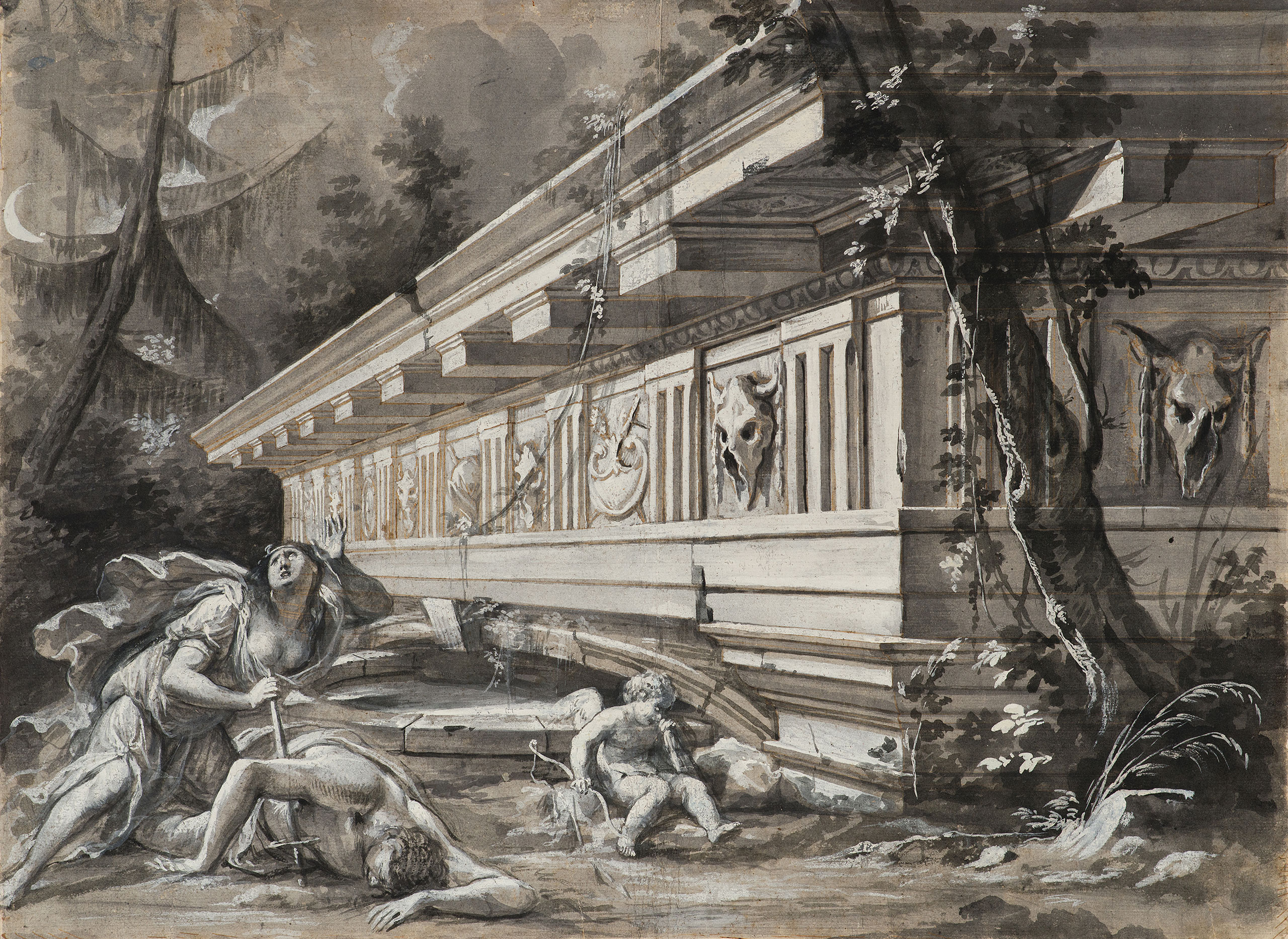
Baratta
Carlo Alberto
Pyramus and Thisbe
Pen and black ink, brush and grey wash with highlights
in white gouache.
398 x 551 mm (15 10/16 x 21 11/16 in.)
Initially self-taught by studying the works of Genoese Baroque artists including Valerio Castello, Domenico Piola and Gregorio and Lorenzo de Ferrari, Carlo Baratta finished by entering the Accademia Ligustica (founded in 1751) at the age of twenty-four. Like his contemporary Giovanni David, Baratta was very active in theatre and scenography. From 1782, he worked for the Sant’Agostino theatre – considered Genoa’s principal public theatre since its creation in 1702 – and where Paganini would make his first performances. There are drawings that bear witness to this activity such as Underground Staircase, of Piranesian inspiration, held at the Palazzo Rosso in Genoa (Inv. 1639). Unlike Giovanni David however, Baratta would never leave Genoa. The two artists collaborated occasionally and it was Baratta who completed David’s Saint Agnes cycle at the Nostra Signora del Carmine e Sant’Agnese church.
Baratta painted several works for Ligurian churches, for example, the Apparition of the Virgin found in the sanctuary at the Nostra Signora dell’ Orto cathedral in Chiavari; the Translation of the Image of Our Lady of the Garden for the vault of this same cathedral, a Presentation at the Temple in the Basilica of Santa Maria Assunta in Camogli, and even an Education of the Virgin in the Capuchin convent in Voltaggio. During the revolutionary period, Barrata was responsible for organizing a museum intended to bring together works confiscated from religious orders under Napoleon.
This spectacular sheet, resembling a theatre set, stages the nocturnal drama of Pyramus and Thisbe. Ovid tells the story of the young Babylonians’ double suicide in his Metamorphoses (4, 43-166). Despite their parents’ opposition, Pyramus and Thisbe love each other and decide to meet at night outside the city, near King Ninus’ tomb next to a “tall mulberry tree” with “abundant fruit as white as snow”. The first to arrive at the meeting place, Thisbe meets a lioness fresh from slaughtering oxen. Dropping her veil, she flees and takes refuge in a cave. The lioness seizes the veil and soils it with her blooded mouth. When Pyramus arrives, he discovers the bloody veil and believing Thisbe killed by the beast, falls on his own sword. His blood soaks the roots of the tree and spurts onto its fruits, turning them dark red. Returning to the meeting place, Thisbe too, kills herself in front of Pyramus’ body. The story was often translated throughout the Middle Ages and taken up and embellished by many playwrights: in the 15th century, Masuccio of Salerno was inspired to write Giannoza et Mariotto; also Luigi da Porto (1485-1529) for Giuletta et Romeo and later freely adapted by Shakespeare. At the end of the 18th century, Pyramus and Thisbe’s story was also frequently set to music.
Baratta provides a relatively faithful representation of Ovid’s text: the mulberry tree is placed to the right of the scene, the King of Babylon’s tomb in the centre. This appears to be the upper part of a buried temple, of which we can only see the entablature and the cornice, probably a consequence of medieval translations of the text that sometimes speak of a buried mausoleum. Whatever the case, the imposing construction provides the artist with an opportunity to demonstrate his science of perspective. This is characteristic of a taste for architectural and antique motifs common at the end of the 18th century. Bucrania – associated with the Doric order in Renaissance architectural treatises – are usually placed in metopes as is the case here, or on altars. They evoke the skulls of sacrificed oxen hung in temples during Antiquity and therefore symbolize victims offered in sacrifice to the Gods or the sacrifices that accompanied funeral services during the Roman Empire – here, extended into a symbol for the young lovers’ gesture of sacrificing their lives for each other. The fountain mentioned by Ovid (sometimes appearing as a river in the medieval texts) is attached to the tomb, no doubt for convenience of representation. A grieving cupid is placed next to it as a symbol of Pyramus and Thisbe’s tragic love.

